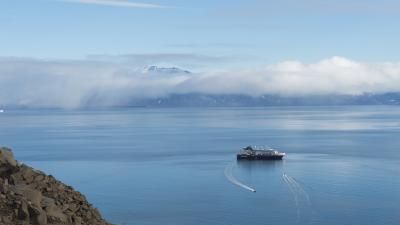
Marine heatwaves and sea ice: implications for Arctic navigational safety
In this blog, Dr Bahareh Kamranzad discusses how her research will support Arctic navigational safety in a rapidly changing climate.
This page is approximately a 4 minute read
This page was published on

Professor Dewan Ahsan, Co-head of the Danish Center for Risk and Safety Management at the University of Southern Denmark
Over the past decade, cruise ship operations in Arctic waters have expanded significantly – by approximately 37% in terms of both the number of vessels and the total distances sailed.
This expansion is particularly evident in high-profile destinations such as Svalbard (Norway), Iceland, Greenland, and northern coastal areas of mainland Norway, where visitor numbers have surged. For example, in Svalbard, a key node for Arctic cruise itineraries, the number of cruise passengers disembarking ashore rose from 1,769 in 2020 to 2,367 in 2021 – an increase that signals a broader trend of intensifying tourist activity across the region.
This growing interest in the Arctic’s remote and pristine landscapes pose both opportunities and risks. While the influx of tourism contributes to local and national economies, it also increases the risk of maritime accidents in one of the world’s most challenging environments. Harsh weather, shifting sea ice, limited infrastructure, and vast distances from mainland pose considerable risks to passenger safety, ecosystem integrity, and the wellbeing of local communities.
Maritime safety standards have seen considerable improvement in recent years, particularly through the implementation of the International Maritime Organization (IMO)’s Polar Code, which sets mandatory safety and environmental requirements for ships operating in polar waters. However, the emergency management of large-scale cruise ship incidents in the Arctic remains a substantial operational and logistical challenge.
These challenges highlight an urgent need for Arctic nations to develop more integrated, comprehensive, and coordinated strategies for cruise ship risk assessment and emergency preparedness. While frameworks such as the Polar Code have laid important groundwork, national-level implementation and preparedness vary significantly across the Arctic region.
There is also a lack of research examining how Nordic Arctic nations have developed and operationalized their national risk assessment plans in relation to cruise tourism. It remains unclear to what extent these plans include risk mitigation strategies, cross-border coordination mechanisms, and, critically, the capabilities of rapid rescue systems to respond effectively to large-scale cruise ship incidents. Addressing this knowledge gap is essential to strengthening regional resilience and informing more effective risk management policy and emergency planning for cruise ship operations in the Arctic.
This research project seeks to address a critical knowledge gap in Arctic cruise ship safety by examining how Nordic Arctic nations – Norway, Denmark (Greenland), and Iceland – assess and manage the risks associated with cruise tourism.
By analyzing their approaches, the project – ‘Managing Risk: Rescue Capability Assessment for Cruise Ship Accidents in the Nordic Arctic’ – aims to identify strengths, weaknesses, and gaps in preparedness and response capability. A key outcome will be to propose a practical, holistic methodology for assessing risk and rescue readiness tailored to the unique hazards of Arctic cruise tourism.
To achieve the goals, the project will address the following core questions:
This research is situated within a broader context of rapid change and growing interest in the Arctic cruise ship industry. Climate change is reshaping Arctic Sea routes and enabling longer tourist seasons, further increasing vessel traffic in ecologically fragile and operationally risky areas. At the same time, geopolitical tensions and evolving governance frameworks are raising new questions about Arctic cooperation, sovereignty, and shared responsibility in emergency management.
In this context, it is intended that the findings of this project will contribute to ongoing and much-needed international efforts – such as those led by the Arctic Council to strengthen maritime safety and environmental stewardship in the Arctic.
If you would like to find out more about this project, you can get in touch at dah@sam.sdu.dk.
